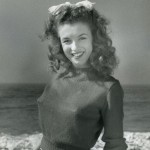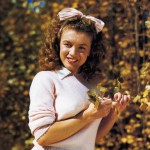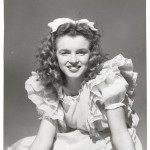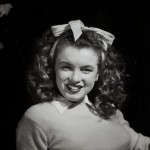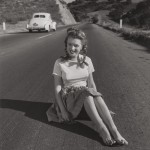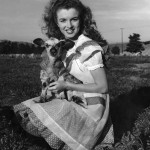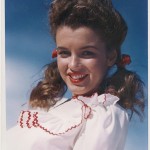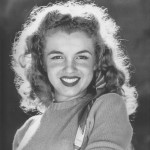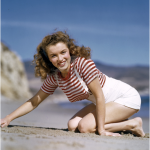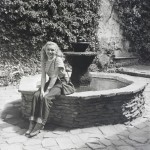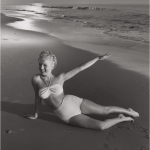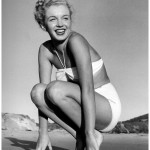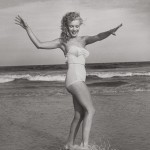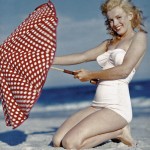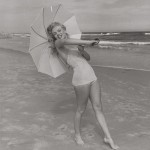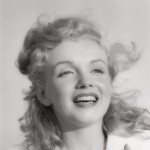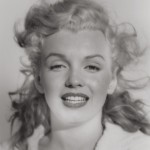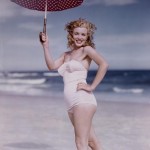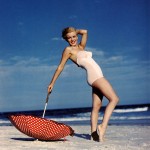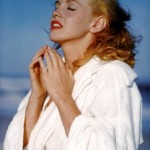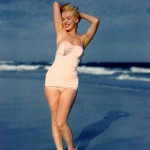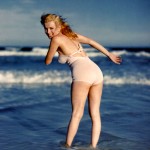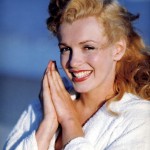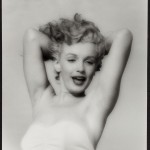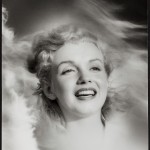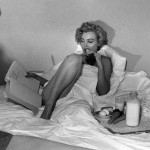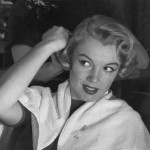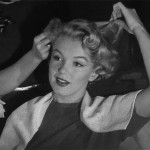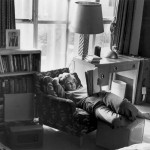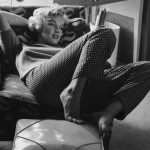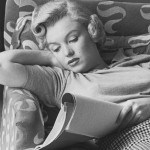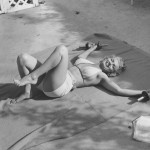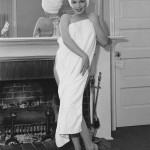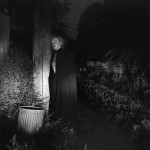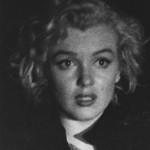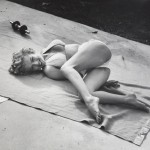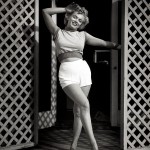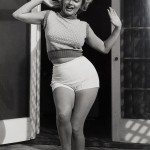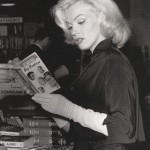1945
1946
1949
1952
1953
Andre de Dienes, one of the first and perhaps most renowned photographers of Marilyn, was born in Transylvania in 1913. Tragically at the age of fifteen his mother committed suicide, driving a young de Dienes to pack up and leave home, heading west across Europe in 1928, mostly on foot until he arrived in Tunisia in the north of Africa. He made a basic income from being an odd job man, turning his hand to whatever he could to raise a few coins and also it was in this time his artistic side began to flourish as he learned how to paint. And also it was at this point in history where a crucial turning point can be marked; de Dienes purchase of his first camera, a 35mm Retina. He continued on his travels, venturing across Europe he arrived in Paris in the year 1933 to study art, and shortly after another notable purchase can be mentioned, his second camera, a Rolleiflex. Perhaps this was the turning point for de Dienes to now want to capture the subject of his artwork with a simple, yet complex machine that captures an image onto film, rather than a humble paintbrush and pencils. And the switch paid off; he became totally fascinated with photography which in the end he turned into his living. He worked for publishing companies such as the communist newspaper La Humanite, and was also under the employment of The Associated Press until 1936, when Parisian couturier Captain Molyneux saw his work and urged him to take up a role as a fashion photographer.
1938 would be the year in which de Dienes received a big break, in the form of Arnold Gingrich, editor of Esquire magazine offering him work with the magazine out in New York, and also financially helped with the cost of the trip. Upon his arrival de Dienes began work for Esquire as well as other big names such as fashion bible Vogue, Life magazine and also Montgomery Ward. Whenever presented with time off from his work, de Dienes was noted to enjoy vacationing around the more picturesque parts of the USA, photographing the glorious sights of the Apache, Hopi, and Navajo reservations and their inhabitants. Many years of work in New York, and many vacations to America’s most naturally beautiful destinations followed up until 1944, when de Dienes grew dissatisfied and bored with his role as a fashion photographer, and once again packed his bags and left for pastures new. This time he set his sights on California, the bright lights of Hollywood in specific where he settled and began work on the two subjects he felt more artistic passion for; nudes and landscapes. It was nature, both in the naked form of a human and the beauty of a landscape untouched by the hand of man that drew out the most notable work from de Dienes. He considered it bad form to alter or manipulate any photograph, citing that it was the endurance, the skill, the patience and the imagination of the photographer that made his work great. He championed natural, untouched beauty in front of the lens as much as he did behind it.
The year 1945 would be a highly notable one for de Dienes, for this was the year he would first meet and work with the young lady the world would later come to know as Marilyn Monroe. At the time the nineteen year old Norma Jeane Baker was a model on the books of Emile Snively’s Blue Book Model Agency, and after taking a call from de Dienes and being informed of an idea for a project involving artistic nude shots Ms Snively informed him of Norma Jeane, a new name on her books who she thought might be interested in the job with de Dienes. And after suggesting as much to Norma Jeane, a meeting was arranged and she was sent on her first assignment that day, being given de Dienes address upon where she arrived later that afternoon. In his memoirs, de Dienes remembers the first time he met Norma Jeane vividly and with much affection and enthusiasm; ‘When Norma Jeane arrived at my bungalow later in the afternoon, it was as if a miracle had happened to me. Norma Jeane seemed to be like an angel. I could hardly believe it for a few moments. An earthly, sexy-looking angel! Sent expressly for me! The impact Norma Jeane had on me was tremendous. As minutes passed, I fell more and more in love with Norma Jeane; there was an immediate rapport between us. She responded to everything I said. She started to look around in my room examining all the pictures I put on the walls and began asking questions. I had the immediate feeling that she was something special, something different from most girls and models I had met before her, mainly because she was so eager to ask questions about me and the pictures I put on the walls. She wanted to know many things right away, she was interested in me! She was utterly sincere; she did not wish to speak about herself, except when I asked her my own questions. She was sincere in wanting to know who I was and what I was doing with my life, and I began to amuse her exceedingly with all sorts of stories that ran through my mind and I just kept dishing them out to her. I still remember it as clearly as if it happened just recently’.
He even recalls the outfit she wore in crystal clear detail, describing her ensemble as a pale pink sweater which clung to her curves, and a matching ribbon in her curly hair, and that her rosy cheeks matched the pink he noted in that ribbon and the sweater. One can only imagine how angelic and fresh she looked to him on that afternoon. He confessed to be ‘completely love struck’ with Norma Jeane from the first moment he laid eyes on her, and it was with great relief when she explained that she was separated from her husband (James Dougherty) when he questioned the wedding band present on her ring finger still. She explained that modelling was her new goal rather than the duties of being a wife, and also expressed interest to him in becoming an actress. He proposed an idea to her, and that was to pack up and leave town for a road trip with him, to find the most beautiful natural scenery to take the most beautiful natural photographs of Norma Jeane. She excitedly agreed and a few days later they left Los Angeles and their journey of discovery. It was at all the places they stopped along the way, from farms to haberdashery stores, gas stations to diners, that de Dienes noticed how Norma Jeane seemed to attract men like bees to honey, and felt quite proud to be the one spending time with her in the role of photographer, even though it can be said that even back then he harboured desires towards her. Desires he respectfully kept to himself for that moment at least, but not for long at all.
Their first overnight stop on the journey was at Timberline Lodge in Mount Hood, Oregon, where bad weather hampered the driving conditions and de Dienes decided it would be best to wait until morning to travel further. Taking the only room available, with comprised of a double bed rather than two singles, did not go down so well with Norma Jeane though, who stated she would prefer they drove on until they reached the cabins in the woods so they could have separate beds. And so relenting to her wish De Dienes continued to drive a dusk set in and the snow became heavier and heavier, with them able to travel no further than a place named the Government Lodge where their car got stuck in a drift outside. It would be here where Norma Jeane would be the one to relent, and give de Dienes what he sought, a night of blissful intimacy that he treasured for years to come, and respectfully of Marilyn’s memory always refused to go into any detail over. It was also on this trip that de Dienes saw her sex appeal, coupled with such youthful innocence really come alive in front of the camera, capturing exquisite shot after exquisite shot of her lying languidly on a bed covered in just a sheet, or when the weather permitted out in the snow. Of course, that weekend would not be the last time they worked together professionally, although it would be the last they were together intimately.
It was not until just before Labour Day in 1946 that de Dienes would hear from Norma Jeane again, and this time it was as Marilyn Monroe, transition having come and gone with regards to her name. She delivered the news to him after he visited her apartment, and they worked together on a shoot together shortly after this. The next time de Dienes and Marilyn were to work together was in 1952, just after her nude photograph scandal had broken (the set she had posed for in 1949, with Tom Kelley behind the lens). He shot her at her bungalow at the Bel Air Hotel in Stone Canyon, and remarked how lovely she looked to him as always. His last shoot with the actress was in 1953, after she telephoned him at 2am and asked him to pick her up so he could go take her picture. She navigated him to a practically pitch black street where he used his car headlights alone for a source of light, and shot the rather eerie and haunting pictures of a wide eyed, un made-up and un coiffed Marilyn in the dark. That was nine years before her tragic and untimely death, and the last time de Dienes saw her alive was on June 1st, 1961. He had observed her steady decline over the previous few years, and knew of her troubles sleeping, and her reliance on pharmaceuticals. He said the following on how he observed her woes at their last ever meet;‘…..her success was a sham, her hopes thwarted…the next day she left a bouquet outside my door: a selection of her latest photos. Smiling, radiant – utterly misleading; I little guessed that this was our last goodbye.’
As well as the iconic Marilyn Monroe, de Dienes also photographed Hollywood heavyweights such as Elizabeth Taylor, Marlon Brando, Henry Fonda, Shirley Temple, Ingrid Bergman, Ronald Reagan, Jane Russell, Anita Ekberg and Fred Astaire. He was considered one of the best, if not the best glamour photographer working in Hollywood at the time, and his pioneering techniques from behind the lens to behind the curtain in the darkroom were well documented in major publications such as Classic Art Photography, U.S Camera and figure Annual to name a few.
De Dienes was twice married, although never a father, and died of cancer in 1985.
His work, can be summed up no greater than in the following quote; ‘Dienes was a man not interested in the glamour or the politics of his work. For him it was about creating something beautiful and nurturing, an idea of the feminine ideal.'[/vc_column_text][/vc_column][/vc_row][vc_row][vc_column width=”1/1″][vc_column_text]


